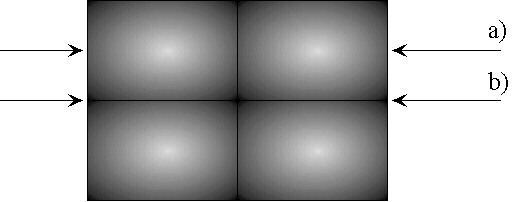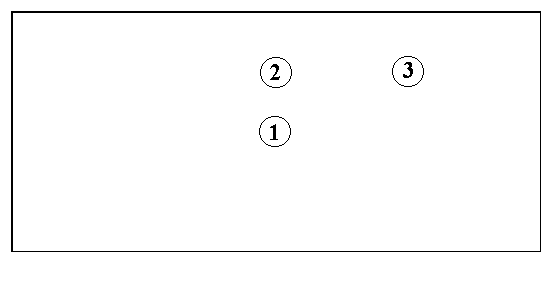Section 4.1
a) Start with a frequency of "C" = 256 Hz. Use Pythagoras technique of going up by a fifth and staying within one octave to generate 4 new notes. What are the frequencies of these notes? This is a pentatonic scale.
b) Now, assume you have a metal bar with a length of 46 cm which is tuned to the first note of the scale, "C". What should the length of a second bar be to make an interval of a perfect fifth higher? The frequency of a metal bar depends on 1/L2 where L is the length of the bar.
The fundamental frequency of a metal bar is given by
 ,
,where L is the length of the bar and the other quantities are not important.
a) If a bar is 0.9 m long and has a resonant frequency of 212 Hz, what is the resonant frequency of a bar that is 0.45 m long?
b) If you want to raise the resonant frequency by an octave, want length should you use?
A metal bar is 35 cm long and has a fundamental frequency of 440 Hz. I want to make another bar a Perfect Fourth lower in pitch. How long should I make the new bar? Remember, the frequency of a metal bar depends on the SQUARE of the length.
A metal bar is 30 cm long and has a fundamental frequency of 480 Hz. I want to make another bar that has a frequency an octave higher in pitch. How long should I make the new bar? Remember, the frequency of a metal bar depends on the SQUARE of the length.
An interesting question came up during the demonstration of the projects: if you copy the lengths of the bars in a wind chime, but you scale it up, do the intervals stay the same? This problem will answer that question.
a) I happen to find two metal bars, identical except for their length. One is 36 cm long and has a frequency of 550 Hz. The other bar is 32.2 cm long. What is the frequency of the second bar and what is the musical interval between the two bars?
b) I now make new bars, each one 1.75 times longer than the original bars. What are the frequencies of the new bars?
c) What is the musical interval between the new bars and is it the same or different from the interval found in part a)?
The frequency of a vibrating bar is inversely proportional to the square of its length.
a) I have two identical bars, except that one has a length of 22 cm and the other has a length of 19 cm. What is the interval between them?
b) How long must a make another bar to be a perfect fifth above the 22 cm bar?
a) I happen to find two metal bars, identical except for their length. One is 36 cm long the other is 44.1 cm long. What is the musical interval between them?
b) I really want an interval of an octave, but, of course, I can only shorten the bars. Which one should I shorten and how long should it be to make the two bars an octave apart?
A metal bar can have many different modes of vibration. One in a longitudinal wave along the bar:

This acts like a closed-closed air column, in that there are anti-nodes at the ends of the bar. However, the velocity of sound in a metal bar, like aluminum, is 5000 m/sec. Sketch the first three modes of vibration of the bar and give the frequency, if the bar is 0.9 meters long.
a) A balaphone is an African xylophone. It has wooden bars as the oscillators. A professor in the Art Department has built several one year demonstrated for the class how he makes them. One of the most important things that he needs to know is exactly where the nodal lines of each bar are, as this is where the bar will be attached to the frame of the instrument. To do this, the builder places the bar on a soft piece of foam rubber, sprinkles some sawdust on the bar an keeps tapping on the bar. What nodal lines would he have seen?

b) Why is this the pattern observed, rather than the nodal lines for some other mode of vibration?
c) From a side view, sketch this mode of vibration.
Section 4.2
State whether the following series correspond to an open-open tube, an open-closed tube, a vibrating bar or none of these. One or more of the lowest frequencies may be missing. If you do recognize the series, give the fundamental frequency.
|
|
Type of series |
Fundamental |
|
335.2, 502.8, 670.4, 838.0 Hz  |
|
|
|
223.4, 616.6, 1206.4, 1995 Hz  |
|
|
|
530.5, 742.7, 954.9, 1167.1 Hz  |
|
|
|
408.1, 734.6, 1754.8, 2120.4 Hz  |
|
|
The overtones of a vibrating metal bar are 1f, 2.76f, 5.40f. What intervals do the second two overtones form with the fundamental? Express the answers as a combination of Just intervals which come closest.
A metal bar is 32 cm long and has a fundamental frequency of 425 Hz.
a) What is the frequency of its first overtone?
b) I want to make another bar that has a fundamental frequency equal to the first overtone of the original bar. How long should I make the new bar? Remember, the frequency of a metal bar depends on the SQUARE of the length.
Section 4.3
A rectangular cavity filled with air has resonant frequencies at 500 Hz, 700 Hz, and 860 Hz. If the speed of sound in carbon dioxide is 1.25 times smaller, what would these frequencies become if the cavity was filled with carbon dioxide? (Start with fl = v).
What are the first few frequencies of a square cavity 20 cm on each side?
If we have a rectangle with dimensions L1 and L2 we can have sound waves traveling along either direction. The frequencies are still given by f = v/l were v is the velocity of sound. Remember that the wavelengths are related to the length that the wave travels along, so that we will have a series of frequencies in each direction: f1, f2, f3, f4 along L1 and g1, g2, g3 g4 along L2.
a) Calculate the first four frequencies in each series if L1 = 0.076 meters and L2 = 0.15 meters.
b) In lab #4 we will measure the frequencies of a rectangle, but the frequencies we measure are not quite the same as what you just calculated. Rather, the measured frequencies, F, are related to the series above by the Pythagorian Theorem: F2 = f2 + g2. Thus, many frequencies are possible. For instance, f2 and g3 can combine to give:
Write down some of the lowest possible frequencies.
A 2-D cavity has dimension of 30 cm by 40 cm. Fill in the following table and identify all of the intervals with the fundamental frequency. For extra credit, identify the chord that these intervals form. (One note will not fit.)
|
f1 = |
f2 = |
|
|
g1 = |
(f1,g1) = |
(f2,g1) = |
|
g2 = |
(f1,g2) = |
(f2,g2) = |
a) 1-D Overtone series.
Determine whether the following series of frequencies come from a closed-closed air column, and open-closed air column or neither. The lowest frequencies may not have been recorded. If it is a proper series given the fundamental frequency.
| Type of tube | Fundamental | |
| 465.6, 776.0, 1086.4, 1396.8, Â | ||
| 150.3, 310.1, 480.9, 660.4, Â | ||
| 545.1, 726.8, 908.5, 1090.2, Â |
| Series | 350.0 | 425.0 | 550.6 | 700.0 | 818.9 | 850.0 |
| Mode | ||||||
| Series | 550.0 | 630.0 | 687.4 | 825.0 | 836.3 | 1038.0 |
| Mode |
Suppose we measure the following frequencies for a rectangular cavity. Figure out the dimensions of the cavity, assuming the speed of sound is 343 m/sec. You will need to identify the two regular series. To prove that you did this correctly, show how to make up the rest of the combination frequencies. There was one problem with the apparatus, however, frequencies lower than 400 Hz could not be measured. Thus, the fundamental of one series is missing.
|
424.7 |
555.7 |
716.6 |
833.0 |
849.4 |
921.9 |
1074.9 |
1111.3 |
1155.8 |
1274.1 |
1323.5 |
1370.0 |
1433.2 |
a) Sketch the nodal lines for a closed recangular air cavity in the mode consisting of the second mode in the long direction and the third mode in the short direction.
b) If the cavity is 0.25 meters by 0.15 meters, what is the frequency of this mode?

Sketch the amplitude of this wave along the lines indicated by arrows a) and b).
a) A rectangular cavity 30 cm by 10 cm has a microphone in the bottom plate at position 1). What are the first three modes of the closed cavity that the microphone can detect? (Hint, if made has a nodal line at the position of the microphone, the microphone will not detect that mode).
b) Repeat a) for the microphone at position 2).
c) Repeat a) for the microphone at position 3).

In analyzing the waves in the rectangular cavities, we must consider the fact that the waves are in two dimensional, instead of one dimensional in an air column. The question then comes up: why don't we have to worry about the third dimension?
a) Just from your memory, what is the approximate height of the cavity in the vertical direction?
b) What is the frequency of the fundamental mode in that direction?
c) In addition to the 2-D modes, we can have simple modes in the vertical direction and combination modes given by:
Why haven't we worried about this possibility?
Section 4.4
So far, we have analyzed a tube or rectangular cavity and determined the resonant frequencies of the cavity. Really, what is useful is the reverse. If we measure the frequencies we can determine the dimension of the cavity. This will be true even if we cannot see the cavity directly (either it is too small or too far away).
a) What length of tube will produce the following set of frequencies: 234 Hz, 468 Hz, 702 Hz ?
b) What length of tube will produce the following set of frequencies: 986 Hz, 1479 Hz, 1972 Hz ? The difference here is that I did not record the fundamental, so you will need to figure that out. Assume in both parts that the speed of sound is 343 m/sec.